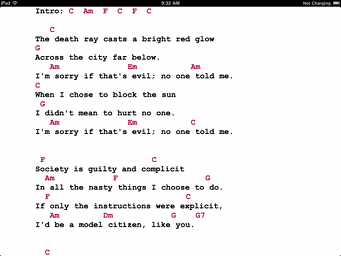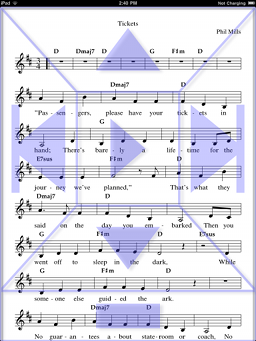Introduction
Welcome to AutoSongbook, an automated scroller and database for songs and set lists. (Originally, "Timely" and renamed to avoid search conflicts.)
The primary purpose of this program is the display of documents that scroll automatically according to user-supplied time estimates. Though content is flexible, the design is tailored to documents that represent songs and thereby provides hands-free prompting during a musical performance.
A secondary purpose is combining documents into collections (e.g. set lists of songs) and presenting those collections with automatic scrolling. Set lists created this way may be saved for re-use or as historical reference with names, dates, and notes.
When scrolling a file, AutoSongbook keeps the portion that matches the current elapsed time near the center of the screen rather than dictating a current line. AutoSongbook is also flexible about file formats, supporting plain text and HTML, as well as .pdf, .doc, .rtf and others as specified here. AutoSongbook also makes no adjustments to the file content but simply scrolls the provided pages in the time specified.
The Screen
AutoSongbook uses a split screen view to show a list of song collections on the left and the songs themselves on the right. Songs are shown with their names and their length in minutes and seconds. When the program is first installed, the only collection predefined is "All Songs", which represents all of the songs known to the database. Songs become part of the database by being synchronized with the AutoSongbook program via iTunes. (See Apple's description of iPad File Sharing for details.) Score files for a few public domain songs are included with the program as samples.
At the bottom of the screen are buttons for creating a new set list and for accessing help. Each item, whether a set list or a song, has a blue disclosure button that reveals a screen for editing its details. Choosing to edit details adds "Cancel" and "Done" options.
Tapping a set list provides an "Edit" function. Entering edit mode allows the deletion of a set list, the removal of songs from a set list, or an option to add songs to the set list. Note that removing a song from the set list does not remove it from the song catalog. While in edit mode you may also rearrange song order by using the 'list' icon on the far right of each song entry to drag up or down.
Tapping a song displays a pop-up window with the names of any set lists that contain that song.
Double-tap either a set list or a song to present it in its own window with auto-scrolling.
When a song is being automatically scrolled, AutoSongbook shows the content of its file overlaid on the entire application window. Tapping the screen at that point pauses the song and shows transport controls for paging back, continuing, paging forward, or exiting. If the song is part of a set list that is being displayed, there are additional controls for skipping backward or forward in the set list. A double-tap will restart the current song in the set list.
Edit details
The additional information entered for a set list is the name, the date, reference notes, and the number of seconds to pause between songs. Set lists are shown in sorted order according to date.
The additional information entered for a song is the name, beats per minute, and reference notes as information fields. The song length in seconds (or in minutes:seconds format) is used to control the scroll speed of the song content. You can specify a lead-in delay time for each song in the same formats, handy if you need to attach a capo or switch instruments. The start note is a cue pitch that is optionally played just before the song begins. The Delete button that is shown when editing song details will completely remove both the database entry for the song and its associated file.
With version 1.1 it's possible to specify a link to an audio file within your iPod library as part of the song's details. This will set the song's length from the iPod information and will enable a switch to turn synchronized audio on or off while scrolling.
Settings
Use the Settings application to control some behavior within AutoSongbook.
The on/off setting called "Play first note" controls whether cue notes for songs sound as the song starts.
The on/off setting called "Auto-advance sets" controls whether songs follow each other in a set with no intervention. Turning this off means you have complete control over when you move between songs.
The on/off setting called "Single-tap songs" gives you the option of scrolling a song with a single tap instead of displaying set lists that reference the song.
The on/off setting called "Skip on continue" controls whether a song continues from where it was stopped or skips to the displayed location. Note that this setting has no effect for songs that are linked to audio.
"Page percentage" can be used to control how much of a page is skipped when moving back or forward using the transport controls. The default is 80%.
The slider labeled "Jump/smooth scroll" controls the style of scrolling of a song file. Jump scrolling moves blocks of the file into view while smooth scrolling provides frequent small screen updates. Exact behavior depends on the length of the song and the use of portrait or landscape orientation.
Credits
Concept, design, and development by Phil Mills.
Includes "MGSplitViewController" code by Matt Gemmell.


